Damselfly
Active member
Along with friends Skip Otto, and Ken and Karen Robichaud, we headed up to Stratton, ME for three days of hiking to grab some Maine 4K peaks: Saddleback, Horn, Sugarloaf, Spaulding, Abraham, So. Crocker, Crocker and Redington.
On our first day we all met at the Saddleback Ski Area. We began hiking the ski slopes in somewhat misty and cloudy conditions and by the time we reached the summit, we were getting pelted by a driving rain. We hiked what should have been a beautiful ridge in the pouring rain with no views, but still had a good time just being out hiking.

We found the Saddleback Ski Area to be 'hiker friendly.' They had trail maps outlining which ski trails to hike up in a box outside the rear door to the lodge, and they allowed us to change out of our wet and cold clothes when we returned.
As we drove up towards Stratton to the place where we would be staying, we saw our first moose grazing by the side of the road. By the end of our trip, we would see several more.
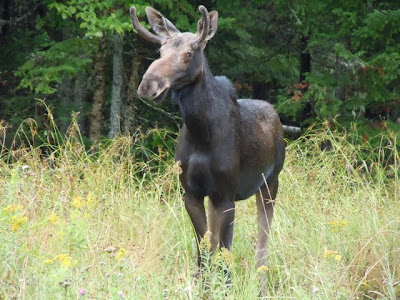
We checked into the Maine Roadhouse for our two-night stay. We had heard that it was convenient, hiker-friendly, cheap, that there was a free washer/dryer there, and a communal kitchen. And while all of that was true, the place was dirty and ill kept - and we jotted down the names of other motels in the area should we return to the area someday, as it’s doubtful we’ll ever return there again.
Day two would be our biggest hike - Sugarloaf, Spaulding and Abraham, a 17-18 mile round trip. We started up the Caribou Valley Road early in the morning and within the comfort of Skip’s truck, were up to the metal bridge a little after 7:00 in the morning. We hiked the remaining .2 miles to the AT trailhead and were surprised to see a Toyota Corolla that far. All the chatter on VFTT forums about the CVR can’t change these facts: the road and bridges are in sketchy shape and deteriorating a bit each year; trucks and SUV’s with clearance do best and can generally make it to the steel bridge without incident; and some drivers have a greater tolerance for risk than others do.

As it crosses the CVR, the AT looks more like a herd path, but the white AT blazes are evident as is some flagging. Within a couple of tenths, we had to cross the South Branch River. While the crossing can be tricky, hikers had put up a plank which served as a bridge across a couple of boulders.
Trail conditions along the AT varied from steep rock ledges and rock slides, to muddy sections, to walks through pine forests, and to dry soft trails through birch glades. With the exception of an occasional long distance hiker, we had the trails and summits to ourselves.
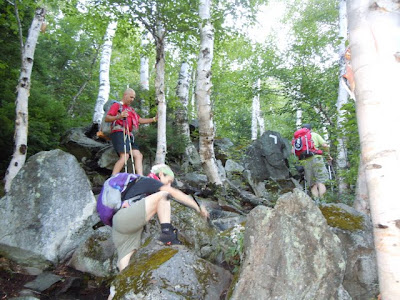
Sugarloaf, with fine views, was an easy .6 miles off the AT. Spaulding, a mostly wooded summit, was next. We took a break on each summit, and another break at the Spaulding Lean-to.
As we approached the shoulder leading up to Mt. Abraham, its rock fields finally came into view. Hiking up to Abraham was the highlight of our three days. It was a beautiful summit with rock fields similar to those experienced in the northern Presidentials with rough rock and 360 degree views. It was now just past 2:00 and we were only half done with our journey.
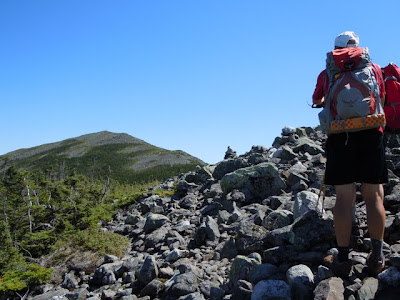
After reviewing our options the night before, we had decided that that instead of hiking it as an “in and out” (regain the elevation up Spaulding and Sugarloaf?), or as a “traverse” (hours to set up a shuttle ) – that we would follow VFTT member Joe Cedar’s tip to hike out via a herd path that we saw at the Abraham Trail / AT junction.
While it didn’t save us any miles, the hike out, mostly downhill, along a herd path and logging roads, saved us incredible effort, energy and it shaved hours off our possible hiking time had we returned via the AT.

As advised, the herd path leaves the junction of the Abraham Trail and AT. We followed this in a mostly westerly direction. The herd path was sometimes open and sometimes overgrown; sometimes flagged and sometimes not; but the tread way was almost always apparent and it was clear that this path received a lot of use.
We got to an area that was recently logged and briefly lost the path, but by staying close to the woods on the left and walking over the logging slash, we quickly regained the herd path. After about 30 minutes, it dropped us onto the first of several logging roads.
We knew that we needed to head north to reconnect with the CVR, and the logging road often went in circuitous directions, shaking our confidence a bit. But the bottom line is: take a RIGHT turn at each fork or at each new logging road intersection, and voila… you’re back on the CVR. The return trip from the summit of Abraham back to our car only took us 3 ¾ hours. I can’t imagine that we could have hiked the AT back over two peaks along a rocky 8 miles in this time.
After getting back to our car and driving out, we drove a short bit past Sugarloaf Ski Area to "Hugs Italian Restaurant." Despite it's homely appearance on the outside, they served up some great food, and we highly recommend it!
The next morning (day 3) we set out and within minutes, came upon four moose in a wetland area, including a cow and her calf. Now that’s a nice start to the day!
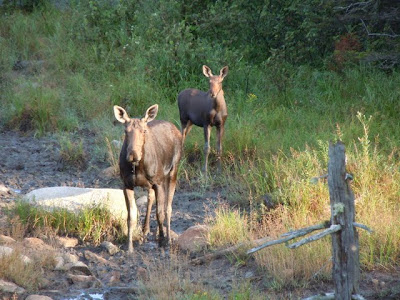
It was another trek up the CVR… but we were pros now. Again, the road is sketchy, but doable.

As we climbed up the AT towards So. Crocker, the first half the trail was fairly moderate, and the second half a bit more steep. You have to gain about 1700’ in 1.8 miles, so do the math and you’ll know it’s going to be steep. But just as other trip reports have laid out, it took us about 1:15 to climb South Crocker, 40 minutes to hike to Crocker (550’ gain), and 35 minutes to return to South (390’ gain). Including breaks on both summits, we were ready to begin our hike to Redington at the 3-hour mark.
I had paid particular attention to Tim Lucia (VFTT’s bikehikesfish) and Jeremy Clark (FranklinSites.com hiking guide) trip reports. With an evident herd path off the summit and good intel, it was a pleasant bushwhack/herdpath hike over to Redington. The only tricky spot was when the herd path dropped us into the AT scenic boundary corridor. But as the intel suggested, we turned right onto this corridor, and after a few feet, looked for the herd path that turned left and downhill. Easy squeezy if you know what you’re looking for.

We were on the summit of Redington in about an hour and found the canister in some trees just to the right of the large summit clearing.
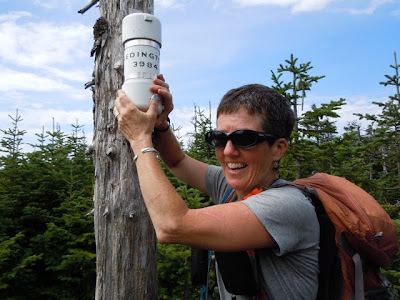
After a nice half hour lunch break, it was time to make the donuts and hike the logging roads home. Following the advice of others before us, we hiked the herd path back to a series of logging roads which would take us back to the CVR: herd path; head right when it splits; left at the ATV kind of road; right /downhill at the next logging road junction. At each junction, rock cairns, flagging and stick arrows pointed us in the correct direction.

Two hours later, we were back at our car and enjoying some cold drinks. Ten miles in 6 ½ hours, which included breaks on all three summits. Not bad. After driving back out the CVR (for hopefully the last time), it was congratulations and goodbyes until our next adventure.
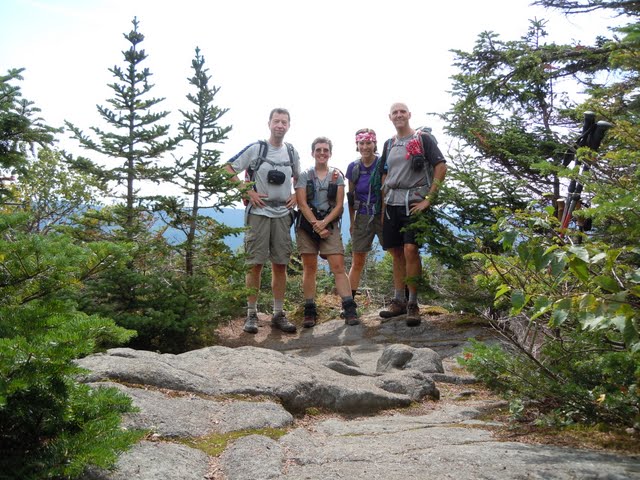
On our first day we all met at the Saddleback Ski Area. We began hiking the ski slopes in somewhat misty and cloudy conditions and by the time we reached the summit, we were getting pelted by a driving rain. We hiked what should have been a beautiful ridge in the pouring rain with no views, but still had a good time just being out hiking.

We found the Saddleback Ski Area to be 'hiker friendly.' They had trail maps outlining which ski trails to hike up in a box outside the rear door to the lodge, and they allowed us to change out of our wet and cold clothes when we returned.
As we drove up towards Stratton to the place where we would be staying, we saw our first moose grazing by the side of the road. By the end of our trip, we would see several more.

We checked into the Maine Roadhouse for our two-night stay. We had heard that it was convenient, hiker-friendly, cheap, that there was a free washer/dryer there, and a communal kitchen. And while all of that was true, the place was dirty and ill kept - and we jotted down the names of other motels in the area should we return to the area someday, as it’s doubtful we’ll ever return there again.
Day two would be our biggest hike - Sugarloaf, Spaulding and Abraham, a 17-18 mile round trip. We started up the Caribou Valley Road early in the morning and within the comfort of Skip’s truck, were up to the metal bridge a little after 7:00 in the morning. We hiked the remaining .2 miles to the AT trailhead and were surprised to see a Toyota Corolla that far. All the chatter on VFTT forums about the CVR can’t change these facts: the road and bridges are in sketchy shape and deteriorating a bit each year; trucks and SUV’s with clearance do best and can generally make it to the steel bridge without incident; and some drivers have a greater tolerance for risk than others do.

As it crosses the CVR, the AT looks more like a herd path, but the white AT blazes are evident as is some flagging. Within a couple of tenths, we had to cross the South Branch River. While the crossing can be tricky, hikers had put up a plank which served as a bridge across a couple of boulders.
Trail conditions along the AT varied from steep rock ledges and rock slides, to muddy sections, to walks through pine forests, and to dry soft trails through birch glades. With the exception of an occasional long distance hiker, we had the trails and summits to ourselves.

Sugarloaf, with fine views, was an easy .6 miles off the AT. Spaulding, a mostly wooded summit, was next. We took a break on each summit, and another break at the Spaulding Lean-to.
As we approached the shoulder leading up to Mt. Abraham, its rock fields finally came into view. Hiking up to Abraham was the highlight of our three days. It was a beautiful summit with rock fields similar to those experienced in the northern Presidentials with rough rock and 360 degree views. It was now just past 2:00 and we were only half done with our journey.

After reviewing our options the night before, we had decided that that instead of hiking it as an “in and out” (regain the elevation up Spaulding and Sugarloaf?), or as a “traverse” (hours to set up a shuttle ) – that we would follow VFTT member Joe Cedar’s tip to hike out via a herd path that we saw at the Abraham Trail / AT junction.
While it didn’t save us any miles, the hike out, mostly downhill, along a herd path and logging roads, saved us incredible effort, energy and it shaved hours off our possible hiking time had we returned via the AT.

As advised, the herd path leaves the junction of the Abraham Trail and AT. We followed this in a mostly westerly direction. The herd path was sometimes open and sometimes overgrown; sometimes flagged and sometimes not; but the tread way was almost always apparent and it was clear that this path received a lot of use.
We got to an area that was recently logged and briefly lost the path, but by staying close to the woods on the left and walking over the logging slash, we quickly regained the herd path. After about 30 minutes, it dropped us onto the first of several logging roads.
We knew that we needed to head north to reconnect with the CVR, and the logging road often went in circuitous directions, shaking our confidence a bit. But the bottom line is: take a RIGHT turn at each fork or at each new logging road intersection, and voila… you’re back on the CVR. The return trip from the summit of Abraham back to our car only took us 3 ¾ hours. I can’t imagine that we could have hiked the AT back over two peaks along a rocky 8 miles in this time.
After getting back to our car and driving out, we drove a short bit past Sugarloaf Ski Area to "Hugs Italian Restaurant." Despite it's homely appearance on the outside, they served up some great food, and we highly recommend it!
The next morning (day 3) we set out and within minutes, came upon four moose in a wetland area, including a cow and her calf. Now that’s a nice start to the day!

It was another trek up the CVR… but we were pros now. Again, the road is sketchy, but doable.

As we climbed up the AT towards So. Crocker, the first half the trail was fairly moderate, and the second half a bit more steep. You have to gain about 1700’ in 1.8 miles, so do the math and you’ll know it’s going to be steep. But just as other trip reports have laid out, it took us about 1:15 to climb South Crocker, 40 minutes to hike to Crocker (550’ gain), and 35 minutes to return to South (390’ gain). Including breaks on both summits, we were ready to begin our hike to Redington at the 3-hour mark.
I had paid particular attention to Tim Lucia (VFTT’s bikehikesfish) and Jeremy Clark (FranklinSites.com hiking guide) trip reports. With an evident herd path off the summit and good intel, it was a pleasant bushwhack/herdpath hike over to Redington. The only tricky spot was when the herd path dropped us into the AT scenic boundary corridor. But as the intel suggested, we turned right onto this corridor, and after a few feet, looked for the herd path that turned left and downhill. Easy squeezy if you know what you’re looking for.

We were on the summit of Redington in about an hour and found the canister in some trees just to the right of the large summit clearing.

After a nice half hour lunch break, it was time to make the donuts and hike the logging roads home. Following the advice of others before us, we hiked the herd path back to a series of logging roads which would take us back to the CVR: herd path; head right when it splits; left at the ATV kind of road; right /downhill at the next logging road junction. At each junction, rock cairns, flagging and stick arrows pointed us in the correct direction.

Two hours later, we were back at our car and enjoying some cold drinks. Ten miles in 6 ½ hours, which included breaks on all three summits. Not bad. After driving back out the CVR (for hopefully the last time), it was congratulations and goodbyes until our next adventure.





















![Grand Canyon, North and South Rims [Grand Canyon National Park] (National Geographic Trails Illustrated Map)](https://m.media-amazon.com/images/I/419Y-ycyVUL._SL500_.jpg)
















![Grand Teton Day Hikes and National Park Map [Map Pack Bundle] (National Geographic Trails Illustrated Map)](https://m.media-amazon.com/images/I/41DB0jvRnbL._SL500_.jpg)












![Yellowstone National Park [Map Pack Bundle] (National Geographic Trails Illustrated Map)](https://m.media-amazon.com/images/I/51kGuJ72qjL._SL500_.jpg)










